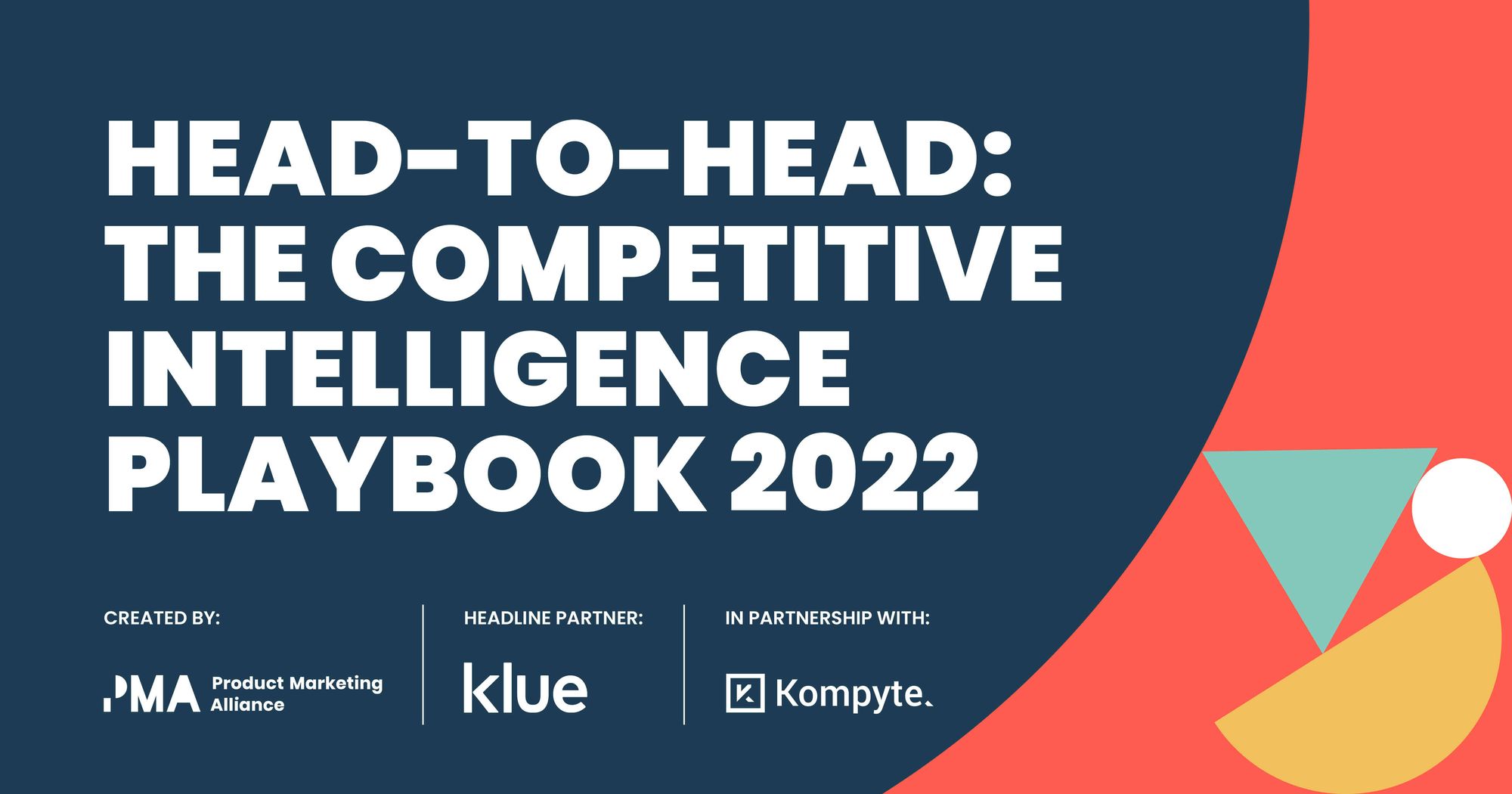Let’s kick things off with a key question: are you communicating internally with your PMM team? 🙋♂️
Yes? That’s awesome. But what we wanna know is: are you looking further afield and keeping a beady eye on how rival companies are occupying their time? If not, then you oughta take a long, hard look at yourself and begin giving competitive intelligence the credence it deserves.
Why? Because it ranks alongside product messaging, market positioning, buyer personas, etc., as one of the most important duties of a product marketer.
So, with that in mind, let's take a moment to refresh our memory and remind ourselves of the basics.
In this article, we’ll be taking a closer look at:
- What is competitive intelligence?
- Research methods for competitive intelligence.
- How to share competitive intelligence results.
- Competitive intelligence tips.
- Competitive intelligence tools.
What is competitive intelligence?
It's a process in which companies gather information on their competitors, customers, and the overall market, before using their findings to introduce appropriate strategies, as they strive to gain an upper hand in their respective market.
It’s like spying - PMM style. 🕵️♀️

Why is gathering competitive intelligence useful?
Competitive intelligence is useful because it gives PMMs an understanding of the activity of market rivals. These insights can be used as a preventative measure against making the same mistakes as other companies.
Let’s take a look at the fast-food industry to bring this to life.
In the late 1990s, hamburger chain McDonald's introduced the McHotdog to its menu, with the surprise addition capturing the attention of fast-food competitors, as well as their customer base.

In theory, it was a masterstroke: how many burger chains also gave their customers the option of buying a hotdog instead?
In reality, however, the McHotdog bombed - badly. So much so, even a seasonal release in 2002 couldn’t add some juice into the dead dog of the nineties.
The point of this food-themed anecdote? We 100% guarantee McDonald's rivals' would’ve been watching proceedings like hawks; any sign of success and they’d be releasing their own version before you could say ketchup and mustard.
Competitive intelligence in this instance saved other brands time, money, (and their pride). McDonald's took the hit, and life moved on.
Gathering competitive intelligence can also do wonders for your pricing strategy, as it gives you an idea of how much your direct and indirect competitors are charging your targeted customers.
Research methods for competitive intelligence
When it comes to gathering research, there are two forms of research methods to consider: internal research and external research.
But how do they differ, and which do PMMs prefer?
What is external research?
As the name suggests, external research involves gathering information from sources outside of your company: for example, newspapers, websites, social media, etc.
When we completed the Competitive Intelligence Trends Report 2022, we decided to explore exactly how product marketers were collecting their CI insights, and we found many were turning to external sources as their main source of information.
After taking a closer look at some of the methods being used by product marketers, we found a number of diverse methods were being used during the competitive intelligence process.
81.2% of PMMs said they check out press releases and media mentions to understand the current activities of those within their market - an increase from 2020 at 76.5%. Plus, an increase from 2020 (74.3%) showed that 76.5% of participants took the relatively old-fashioned approach and headed straight to the source itself, checking out websites and marketing activities.
What is internal research?
With no end of external methods available to those planning competitive intelligence, this doesn’t mean internal methods can’t be used instead. And, as we’re sure you’ve guessed, internal research involves turning to research methods from within the company.
Internal communication is a fundamental part of product marketing in any circumstance, but it can also be the difference between getting mediocre material for your competitive intel or comprehensive insights from people in your organization. The good news? There are several avenues for PMMs to explore in their bid to gain a competitive advantage. 👇
When we surveyed our sample, we found product marketers were making the most of resources under their noses to learn more about their competitors, with simple means of communication such as emails (65.9%) and conversations among peers (47.1%) emerging as the most popular form of internal competitive intelligence research.
In terms of which specific teams PMMs were liaising with most when conducting competitive intelligence, our research indicated the sales teams were identified as the port of call for many PMMs, with a whopping 92.9% saying they turn to them for CI support.
In some corners of the product marketing world, it’s suggested that leadership figures and executives either, a) don’t support the PMM function, b) don’t understand the role of a PMM or c) ignore the role altogether.
So, we’re sure you’ll share our enthusiasm in hearing 77.6% of product marketers we spoke to about competitive intelligence said they’re able to gain competitive intelligence insights from members of the executive/leadership team; a marked improvement on some of the PMM perceptions we discovered among some members of the C-Suite, as we outlined in our C-Suite perceptions report.
How to share competitive intelligence results
If you were a sports coach and knew exactly what the Achilles heel of the opposition was, would you keep your mouth shut and watch your team struggle?
Of course, you wouldn’t. And the same principle needs to be applied when you’re conducting competitive intelligence.
We asked what skills make a rockstar product marketer, and unsurprisingly, collaboration came out on top, with 78% of PMMs saying they value collaboration with coworkers above any other attribute.
Collaboration and effective communication go hand in glove with competitive intelligence. You need to work as a team to share insights and make the most of the important information at your disposal, otherwise, you can miss key insights that could be applied to your strategy.
In an ideal scenario, product marketing professionals the world over would apply this rationale, but to what extent are PMMs actually doing it?
We asked PMMs to rank how open internal teams are when it comes to knowledge-sharing around competitive intelligence on a scale of 1-10, and this generated an average rating of 6.9; only 28.2% of product marketers deemed their in-house knowledge sharing to be worthy of a perfect ‘10’.
Sure, you can collect thorough competitive intelligence results, but what good are they if you’re not spreading the word among your peers and putting your knowledge to good use?
With that sentiment in mind, we burrowed even deeper into the CI habits of a product marketer, checking out preferred methods for sharing intel, once they establish what their rivals have up their sleeve, and here’s what we found… 👀
The very best product marketers need no encouragement when it comes to sharing their competitive intelligence findings with their teams - and this stretches far beyond the product marketing team.
When we completed our research survey as part of our report on competitive intelligence, we found that there were as many as five departments product marketers mainly turn to when sharing results. Ahead of product marketing itself, with sales (82.4%), product (52.9%), customer success (51.8%), executives and leadership (45.9), and marketing (30.6) identified as the key quintet as far as information sharing is concerned, before product marketing even entered the fray.
As for the most common methods for spreading the good CI word? In-person/team-by-team feedback and email segmentation were both earmarked as being the two most popular methods for feeding back to product marketing teams.
Over half (52.9%) expressed a preference for doing this in-person, on a team-by-team basis.
Email was also identified as a popular option, with 34.1% sending segmented emails, while 31.8% typically send a blanket email to all relevant teams.
Some of the PMMs we spoke with (23.5%) also said they share information in person with relevant teams at the same time.
Tips for gathering and sharing competitive intelligence (CI)
We’re not going to beat around the bush: collecting and sharing competitive intelligence can be time-consuming, but there’s no doubting the benefits it can bring to the fore. A heightened understanding of others vying for your precious customers will equip you with an opportunity to improve your product offering as you bid to stave off competition.
We popped together a list of 30 competitive intelligence tips from product marketers who’ve been there, done it, and continue to flaunt their CI shirt.
Here’s a sneak peek into what you can expect from our list, with the following snippets of advice sure to alleviate the strain and help you navigate the path to CI perfection.
"Competitive intelligence is an incredibly important activity for every product marketing team. Every customer-facing team within your organization will likely hear bits of information about competitors, and collecting that in one place is crucial.
"From my experience, a shared Slack channel for competitive intel where people can post updates they are hearing is useful. PMMs can vet those, and update battle cards or different assets as needed.
"If there are a small number of competitors you compete fiercely with, it can also be worth establishing a group like a tiger team to discuss things like objection handling, differentiators, and real-time advice on how to win. All of the information within this team is naturally fed back into core competitive assets as well."
Jeffrey Vocell, Director of Product Marketing at Iterable
“Don’t be afraid to get help from other parts of your organization. Being able to get help from a sales engineer or a developer while you’re reading technical documentation can save a ton of time and help you better understand different personas.”
Mindy Regnell, Senior Marketing Intelligence Manager at Postscript
“Job postings can detail info about their tech stack. For example, if they say ‘looking for an IT manager with experience in Oracle, Kronos’, then you know the company uses these tools.”
Laura Massingham, Director of Product Marketing at Tackle.io
Competitive intelligence: common challenges
Anything worth having doesn’t land in our lap; there are always challenges you need to overcome to reap the rewards.
Competitive intelligence falls under this umbrella. Product marketers can sometimes be faced with challenges en route to unlocking CI’s undoubted benefits.
So, what exactly are some of the obstacles faced by members of the PMM community?
“At my company, there aren’t enough resources. I’m the only PMM.”
“There are a few areas I’m struggling with. I find it difficult to complete an apples to apples comparison, while it’s also tough to find pricing, hard to distinguish what a company does from their marketing hype.”
“It’s difficult to keep every single piece of intel up-to-date.”
“The market we're serving is still light years behind in terms of IT usage. Which makes looking up info that much more complicated.”
“We have no standard framework to work with.”
Competitive intelligence tools
Thought our insights into competitive intelligence were finished, finito, finite?
Well, you’re mistaken, because as a parting gift, we’re steering you towards our PMM Tech Stack, where you’ll find a collection of competitive intelligence tools designed to help you improve the effectiveness of your research.
Plus, we’ve also got an incredibly in-depth guide called Head-to-Head: The Competitive Intelligence Playbook, which is filled to the brim with actionable advice designed to equip you with the knowledge you need to build and refine your competitive intelligence (CI) strategy and ultimately win your market.

And that’s not all! Into the Fray: The Competitive Intelligence Podcast is hosted by Erik Mansur, VP of Product Marketing at Crayon, where he discusses the intricacies of CI with leading experts from the likes of TalkDesk, Imperva, and jane.app who have refined their own approaches.
What are you waiting for? Start as you mean to go on, and set new habits.
Have a nosy.
Don't want the CI learning to stop? We've got a course for that.
With the help of Alex McDonnell, Market Intelligence Lead at Airtable, we have created a Competitive Intelligence Certified: Masters course, designed to go even deeper into equipping you with the essential CI skills.
By the end of the course, you’ll be able to:
- Build a tech tack for CI.
- Conduct win/loss and primary research.
- Visualize your competitive position with a market map.
- Enable sales and customer success to deliver crisp competitive positioning.
- Bring CI to the table in strategy and product decisions.
Face competition with confidence. Cut through the noise.
Get Competitive Intelligence Certified

















 Follow us on LinkedIn
Follow us on LinkedIn





.svg?v=1461f28f41)